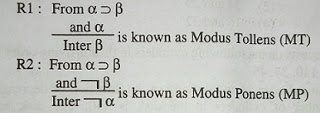Question

a.
Only R1 is correct.
b.
Only R2 is correct.
c.
Both R1 and R2 are correct.
d.
Neither R1 nor R2 is correct.
Engage with the Community - Add Your Comment
Confused About the Answer? Ask for Details Here.
Know the Explanation? Add it Here.
Q. Consider following two rules R1 and R2 in logical reasoning in Artificial Intelligence (AI):
Similar Questions
Discover Related MCQs
Q. In Artificial Intelligence (AI), what is present in the planning graph?
View solution
Q. What is the best method to go for the game playing problem?
View solution
Q. Which of the following statements is true ?
View solution
Q. The first order logic (FOL) statement ((RᴠQ)˄(Pᴠ¬Q)) is equivalent to which of the following?
View solution
Q. Let us assume that you construct ordered tree to represent the compound proposition (~(p˄q))↔(~p˅~q).
Then, the prefix expression and post-fix expression determined using this ordered tree are given as ........... and ............. respectively.
View solution
Q. Let v(x) mean x is a vegetarian, m(y) for y is meat, and e(x, y) for x eats y. Based on these, consider the following sentences:
I. ∀x v(x) ⇔ (∀y e(x, y) ⇒ ¬m(y))
II. ∀x v(x ) ⇔ (¬(∃y m(y) ˄ e(x, y)))
III. ∀x (∃y m(y) ˄ e(x, y)) ⇔ ¬v(x)
One can determine that
View solution
Q. Match each Artificial Intelligence term in List-I that best describes a given situation in List – II:
List – I List – II
I. Semantic Network a. Knowledge about what to do as opposed to
how to do it.
II. Frame b. A premise of a rule that is not concluded
by any rule.
III. Declarative knowledge c. A method of knowledge representation that
uses a graph.
IV. Primitive d. A data structure representing stereotypical
knowledge.
Codes :
I II III IV
View solution
Q. In Artificial Intelligence , a semantic network
View solution
Q. Criticism free idea generation is a factor of ..............
View solution
Q. Consider the following logical inferences :
I1 : If it is Sunday then school will not open.
The school was open.
Inference : It was not Sunday.
I2 : If it is Sunday then school will not open.
It was not Sunday.
Inference : The school was open.
Which of the following is correct?
View solution
Q. Which formal system provides the semantic foundation for Prolog?
View solution
Q. How does randomized hill-climbing choose the next move each time?
View solution
Q. A software program that infers and manipulates existing knowledge in order to generate new knowledge is known as:
View solution
Q. Which of the following arguments are not valid?
(a) “If Gora gets the job and works hard, then he will be promoted. If Gora gets promotion, then he will be happy. He will not be happy, therefore, either he will not get the job or he will not work hard”.
(b) “Either Puneet is not guilty or Pankaj is telling the truth. Pankaj is not telling the truth, therefore, Puneet is not guilty”.
(c) If n is a real number such that n>1, then n^2>1. Suppose that n^2>1, then n>1.
View solution
Q. Let P(m,n) be the statement “m divides n” where the Universe of discourse for both the variables is the set of positive integers. Determine the truth values of the following propositions.
(a) ∃m ∀n P(m,n) (b) ∀n P(1,n) (c) ∀m ∀n P(m,n)
View solution
Q. Match the following terms:
List - I List - II
(a) Vacuous proof (i) A proof that the implication p→q is true
based on the fact that p is false
(b) Trivial proof (ii) A proof that the implication p→q is true
based on the fact that q is true
(c) Direct proof (iii) A proof that the implication p→q is true
that proceeds by showing that q must be true
when p is true.
(d) Indirect proof (iv) A proof that the implication p→q is true
that proceeds by showing that p must be false
when q is false.
Codes:
(a) (b) (c) (d)
View solution
Q. Consider the compound propositions given below as:
(a) p˅~(p˄q) (b) (p˄~q)˅~(p˄q) (c) p˄(q˅r)
Which of the above propositions are tautologies?
View solution
Q. Which of the following property/ies a Group G must hold, in order to be an Abelian group?
(a) The distributive property
(b) The commutative property
(c) The symmetric property
View solution
Q. Given the following set of prolog clauses:
father(X, Y):
parent(X, Y),
male(X),
parent(Sally, Bob),
parent(Jim, Bob),
parent(Alice, Jane),
parent(Thomas, Jane),
male(Bob),
male(Jim),
female(Salley),
female(Alice).
How many atoms are matched to the variable ‘X’ before the query
father(X, Jane) reports a Result?
View solution
Q. Forward chaining systems are ............. where as backward chaining systems are ................
View solution
Suggested Topics
Are you eager to expand your knowledge beyond Artificial Intelligence? We've curated a selection of related categories that you might find intriguing.
Click on the categories below to discover a wealth of MCQs and enrich your understanding of Computer Science. Happy exploring!








